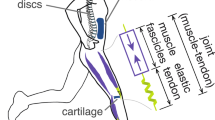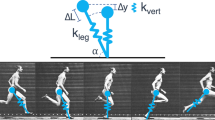Abstract
THE amount of energy used to run a mile is nearly the same whether it is run at top speed or at a leisurely pace (although it is used more rapidly at the higher speed). This puzzling independence of energy cost and speed is found generally among running animals1, although, on a per gram basis, cost is much higher for smaller animals. Running involves little work against the environment2; work is done by muscles and tendons to lift and accelerate the body and limbs. Some of the work is recovered from muscle-tendon springs without metabolic cost3,4 and work rate does not parallel metabolic rate with either speed or size. Regardless of the amount of work muscles do, they must be activated and develop force to support the weight of the body. Load-carrying experiments have shown that the cost of supporting an extra newton of load is the same as the weight-specific cost of running5. Size differences in cost are proportional to stride frequency at equivalent speeds, suggesting that the time available for developing force is important in determining cost6,7. We report a simple inverse relationship between the rate of energy used for running and the time the foot applies force to the ground during each stride. These results support the hypothesis8 that it is primarily the cost of supporting the animal's weight and the time course of generating this force that determines the cost of running.
This is a preview of subscription content, access via your institution
Access options
Subscribe to this journal
Receive 51 print issues and online access
$199.00 per year
only $3.90 per issue
Buy this article
- Purchase on SpringerLink
- Instant access to full article PDF
Prices may be subject to local taxes which are calculated during checkout
Similar content being viewed by others
References
Full, R. J. in Energy Transformations in Cells and Animals (eds Wieser, W. & Gnaiger, E.) 175–182 (Thieme, Stuttgart, 1989).
Pugh, L. G. C. E. J. Physiol., Lond. 213, 255–276 (1971).
Alexander, R. McN. Am. Zool. 24, 85–94 (1984).
Biewener, A., Alexander, R. McN. & Heglund, N. C. J. Zool. 195, 369–383 (1981).
Taylor, C. R., Heglund, N. C., McMahon, T. A. & Looney, T. R. J. exp Biol. 86, 9–18 (1980).
Heglund, N. C., Fedak, M. A., Taylor, C. R. & Cavagna, G. A. J. exp Biol. 97, 57–66 (1982).
Heglund, N. C. & Taylor, C. R. J. exp. Biol. 138, 301–318 (1988).
Taylor, C. R. J. exp Biol. 115, 253–262 (1985).
Cavagna, G. A., Heglund, N. C. & Taylor, C. R. Am. J. Physiol. 233, R243–R261 (1977).
Biewener, A. A. Science 245, 45–48 (1989).
Alexander, R. McN., Jayes, A. S., Maloiy, G. M. O. & Wathutu, E. M. J. Zool. 194, 539–552 (1981).
Huxley, A. F. J. Physiol. 243, 1–43 (1974).
Rall, J. Ex. Sports Sci. Rev. 13, 33–74 (1985).
Fedak, M. A., Rome, L. & Seeherman, H. J. J. appl. Physiol. 51, 772–776 (1981).
Schmidt-Nielsen, K. Science 177 222–227, 1972.
Heglund, N. C. J. exp. Biol. 93, 333–338 (1981).
Thompson, S. D., MacMillen, R. E., Burke, E. M. & Taylor, C. R. Nature 287, 223–224 (1980).
Fedak, M. A. & Seeherman, H. J. Nature 282, 713–716 (1979).
Taylor, C. R., Heglund, N. C. & Maloiy, G. M. O. J. exp Biol. 97, 1–21 (1982).
Alexander, R. McN., Langman, V. A., & Jayes, A. S. J. Zool. 183, 291–300 (1977).
Taylor, C. R., Schmidt-Nielsen, K., & Raab, J. L. Am. J. Physiol. 219 1104–1107 (1970).
Gray, J. Animal Locomotion (Weidenfeld & Nicolson, London, 1968).
Author information
Authors and Affiliations
Rights and permissions
About this article
Cite this article
Kram, R., Taylor, C. Energetics of running: a new perspective. Nature 346, 265–267 (1990). https://doi.org/10.1038/346265a0
Received:
Accepted:
Issue Date:
DOI: https://doi.org/10.1038/346265a0
This article is cited by
-
Effect of cross-slope angle on running economy and gait characteristics at moderate running velocity
European Journal of Applied Physiology (2024)
-
A century of exercise physiology: concepts that ignited the study of human thermoregulation. Part 3: Heat and cold tolerance during exercise
European Journal of Applied Physiology (2024)
-
Design of the Pneumatic Pressure Smart Shoes for an Ankle-Assisted Exoskeleton
Journal of Bionic Engineering (2023)
-
The metabolic cost of turning right side up in the Mediterranean spur-thighed tortoise (Testudo graeca)
Scientific Reports (2022)
-
Non-South East Asians have a better running economy and different anthropometrics and biomechanics than South East Asians
Scientific Reports (2022)



